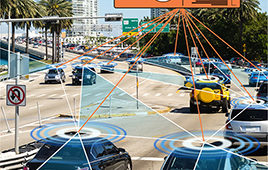Rube Goldberg Machine Contest Winner Pops Balloon in 191 Steps
 |
| Anne Jacobson from St. Olaf College works to reset the team’s machine for its third run during the 2012 Rube Goldberg Machine Contest national finals at Purdue University. St. Olaf won the competition. Courtesy of Purdue University/Andrew Hancock |
This year’s winning Rube Goldberg machine had an end-of-the-world theme that incorporated music throughout the run, ranging from the “Jaws” theme to Beethoven’s Fifth Symphony to the “Indiana Jones” theme. A team from St. Olaf College, a private liberal arts school in Northfield, MN, won the 25th annual contest on March 31, 2012, at Purdue University.
The task for the Rube Goldberg machines this year was to inflate and pop a balloon. The Rube Goldberg competition, sponsored by Purdue’s Phi Chapter of Theta Tau fraternity, rewards machines that most effectively combine creativity with inefficiency and complexity.
Machines must use at least 20 steps to complete the task in no more than two minutes. Teams have three tries to complete two runs. Points are deducted if students have to assist the machine once it has started.
The St. Olaf machine had 191 steps. The team completed one perfect run and one run with one human intervention. It was the second time St. Olaf has won the national competition. The school also won in 2009, the first year it entered the contest.
St. Olaf doesn’t have an engineering program. Many of the students on the team are in physics, while some are in chemistry and one is a music major, team captains Sevy Bialke and Justine Tawel said. The machine effort grows out of a physics class taught by Jason Engbrecht, the team’s adviser. He also was the adviser to the 2009 team.
Purdue University took second place and the People’s Choice Award, voted on by the audience, with a machine that revisited all of the Rube Goldberg challenges in the competition’s 25-year history. The Purdue machine, built by a team from the Society of Professional Engineers and the Society of Hispanic Professional Engineers, had 300 steps. The team completed two runs, each with two human interventions.
Last year, the same team created a machine that had 244 steps, winning it a spot in the “Guinness Book of World Records.” Immediately after this year’s competition, the machine completed a perfect run, qualifying it for another world record.
Pennsylvania State University finished third with a kitchen-themed machine that incorporated food, appliances and utensils.
Other teams competing were from the University of Illinois, University of Arizona, University of Texas, Texas A&M University and Ferris State University.
Jennifer George, Rube Goldberg’s granddaughter and legacy director of Rube Goldberg Inc., handed out two new awards at the competition. The Best Step Award went to Purdue for its use of a finger to pop its balloon.
The Legacy Award, given for a machine that best incorporates humor with critical thinking, went to the University of Arizona. Its machine stood out because it actually looked like a bathroom, complete with a real toilet and sink.
George also announced that the task for next year’s contest will be to hammer a nail. The task was suggested by students who are competing in an online middle school Rube Goldberg contest. Details on that and other Rube Goldberg contests and activities can be found at http://www.rubegoldberg.com
Sponsors for this year’s national competition were Alcoa, Lockheed Martin, Priio, Rockwell Collins, and the Purdue Colleges of Engineering and Technology and the School of Mechanical Engineering.
Rube Goldberg specialized in drawing whimsical machines with complex mechanisms to perform simple tasks. He earned a degree in engineering from the University of California, Berkeley, in 1904. He worked as an engineer for the city of San Francisco for less than a year before becoming a sports cartoonist for the San Francisco Chronicle. He received a Pulitzer Prize in 1948 for his political cartoons published by the New York Sun.
The Rube Goldberg Machine Contest dates back to 1949 when it began as a competition between two Purdue fraternities. It was held until 1955, then revived in 1983 and opened to all Purdue students. The first national contest was held in 1988.
Video: Purdue Smashes Rube Goldberg World Record: http://www.youtube.com/watch?v=bmwB8uR4Bc4




